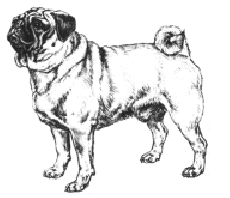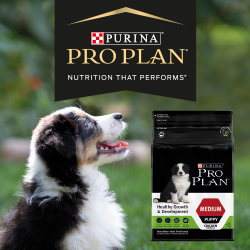Pug
General Information - Pug

Group:
Toy
Size:
Small
Lifespan:
12-15 years
Exercise:
Little
Grooming:
Little
Trainability:
Moderate
Watchdog ability:
Very high
Protection Ability:
Very low
Area of Origin:
China
Date of Origin:
Ancient times
Other Names:
Mops, Carlin
Original Function:
Lapdog
History
The word Pug is derived either from the Latin Pugnus, meaning fist, as the head may have resembled a clenched fist, or from the marmoset Pug monkeys that were popular pets in the 18th century and that the Pug dogs somewhat resemble. Whatever the name, one thing is true: The Pug’s official motto 'multum in parvo' (a lot in a little) fits it exactly. The Pug is somewhat of an exception in the toy group because it is perhaps the only breed to be descended from mastiff forebears. Although its exact ancestry has been lost in antiquity, the Pug retains many mastiff characteristics. This is an ancient breed, one of several miniaturized in Asia, where it was a favourite pet of Buddhist monasteries in Tibet many centuries ago. In China, the facial wrinkles were an essential breed feature, most notably the 'prince mark', or vertical wrinkle on the forehead, which bore a resemblance to the Chinese character for 'prince'. Pugs probably came to Holland by way of the Dutch East India Trading Company. They became quite popular and were recognised as the official dog of the House of Orange after one saved the life of Prince William by sounding an alarm at the approach of Spanish soldiers in 1572. By 1790, the Pug could be found in France; Napoleon’s wife Josephine used her Pug to carry messages to Napoleon when she was imprisoned. Pugs were first brought to England during Victorian times and became incredibly popular with the wealthy, displacing the King Charles Spaniel as the favoured royal breed. Pugs of Victorian England usually had cropped ears, further accentuating their wrinkled faces.
Temperament
Playful and happy, dignified and funny, Pugs do well with visitors, children and other pets. Although sometimes stubborn, the Pug is typically pleasant and anxious to please. It loves to show-off.
Upkeep
The Pug needs daily exercise, either in the form of a lively game or a moderate walk on leash. It does not do well in heat and humidity and should not be kept outdoors. It needs minimal coat care but daily cleaning of facial wrinkles. Its smooth coat needs only occasional brushing to remove dead hairs; however, the wrinkles need regular cleaning and drying to prevent skin infections. The Pug wheezes and snores.
Pug
A breed standard is the guideline which describes the ideal characteristics, temperament, and appearance of a breed and ensures that the breed is fit for function with soundness essential. Breeders and judges should at all times be careful to avoid obvious conditions and exaggerations, as well as being mindful of features which could be detrimental in any way to the health, welfare or soundness of this breed.
Breed Standard - Pug
General Appearance: Decidedly square and cobby, it is ‘multum in parvo’ shown in compactness of form, well knit proportions and hardness of muscle, but never to appear low on legs, nor lean and leggy.
Characteristics: Great charm, dignity and intelligence.
Temperament: Even-tempered, happy and lively disposition.
Head and Skull: Head relatively large and in proportion to body, round, not apple-headed, with no indentation of skull. Muzzle relatively short, blunt, square, not upfaced. Nose black, fairly large with well open nostrils. Wrinkles on forehead clearly defined without exaggeration. Eyes or nose never adversely affected or obscured by over nose wrinkle.
Pinched nostrils and heavy over nose wrinkle is unacceptable and should be heavily penalised.
Eyes: Dark, relatively large, round in shape, soft and solicitous in expression, very lustrous, and when excited, full of fire. Never protruding, exaggerated or showing white when looking straight ahead. Free from obvious eye problems.
Ears: Thin, small soft like black velvet. Two kinds – ‘Button ear’ – ear flap folding forward, tip lying close to skull to cover opening. ‘Rose ear’ – small drop ear which folds over and back to reveal the burr.
Mouth: Slightly undershot. Wide lower jaw with incisors almost in a straight line. Wry mouths, teeth or tongue showing all highly undesirable and should be heavily penalised.
Neck: Slightly arched to resemble a crest, strong, thick with enough length to carry head proudly.
Forequarters: Legs very strong, straight, of moderate length, and well under body. Shoulders well sloped.
Body: Short and cobby, broad in chest. Ribs well sprung and carried well back. Topline level neither roached nor dipping.
Hindquarters: Legs very strong, of moderate length, with good turn of stifle, well under body, straight and parallel when viewed from rear.
Feet: Neither so long as the foot of the hare nor so round as that of the cat; well split-up toes; the nails black.
Tail: High set, tightly curled over hip. Double curl highly desirable.
Gait/Movement: Viewed from in front should rise and fall with legs well under shoulder, feet keeping directly to front, not turning in or out. From behind action just as true. Using forelegs strongly putting them well forward with hindlegs moving freely and using stifles well. A slight unexaggerated roll of hindquarters typifies gait. Capable of purposeful and steady movement.
Coat: Fine, smooth, soft, short and glossy, neither harsh, off-standing nor woolly. Any stripping or trimming of the coat which alters the length, texture or outline must be penalised.
Colour: Silver, apricot, fawn or black. Each clearly defined, to make contrast complete between colour, trace (black line extending from occiput to tail) and mask. Markings clearly defined. Muzzle or mask, ears, moles on cheeks, thumb mark or diamond on forehead and trace as black as possible.
Size: Ideal weight 6.3-8.1 kgs (14-18 lbs). Should be hard of muscle but substance must not be confused with overweight.
Faults: Any departure from the foregoing points should be considered a fault and the seriousness with which the fault should be regarded should be in exact proportion to its degree and its effect upon the health and welfare of the dog and on the dog’s ability to perform its traditional work. .
Note: Male animals should have two apparently normal testicles fully descended into the scrotum.
DNZ No 160
Copyright Dogs New Zealand
28 March 2018
Any departure from the foregoing points should be considered a fault and the seriousness with which the fault should be regarded should be in exact proportion to its degree and its effect upon the health and welfare of the dog and on the dog’s ability to perform its traditional work.





